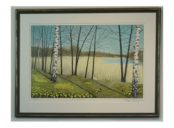Scandinavian design: A Timeless Blend of Functionality and Elegance

Scandinavian Design: A Timeless Blend of Functionality and Elegance
Introduction:

Scandinavian design, renowned for its functional yet elegant aesthetic, has gained immense popularity worldwide. This article provides an in-depth overview of Scandinavian design, its various types and styles, its quantitative measurements, the differences between different Scandinavian designs, and a historical analysis of the advantages and disadvantages associated with this design approach.
An Overview of Scandinavian Design
Scandinavian design is a design movement that emerged in the early 20th century in the countries of Denmark, Norway, Sweden, Finland, and Iceland. It embodies simplicity, minimalism, and functionality while maintaining a sense of elegance. Influenced by the region’s harsh climate and unique environment, Scandinavian design prioritizes practicality, durable materials, and clean lines.
Comprehensive Presentation of Scandinavian Design
There are several types of Scandinavian design, each with its own distinctive characteristics. The most popular types include:
1. Danish design: Danish design is characterized by its emphasis on natural materials such as wood and leather, combined with sleek lines and organic shapes. This style often showcases craftsmanship and attention to detail.
2. Swedish design: Swedish design focuses on simplicity and lightness. It often features pale color palettes, natural materials like birch wood, and functional yet stylish furniture.
3. Finnish design: Finnish design is known for its innovation and experimentation. It combines functionality with artistic expression, featuring bold colors, geometric patterns, and unconventional shapes.
4. Norwegian design: Norwegian design is heavily influenced by nature, with an emphasis on sustainability and eco-friendly materials. It often incorporates elements of traditional craftsmanship, creating a unique blend of modern and traditional design.
Quantitative Measurements of Scandinavian Design
Scandinavian design has garnered significant attention in the design world. Here are some quantitative measurements that demonstrate its popularity and impact:
1. Market presence: Scandinavian design products, such as furniture and home decor items, have a strong market presence globally. Brands like IKEA, Muuto, and Marimekko have become household names.
2. International recognition: Scandinavian designers and architects have received numerous prestigious awards, including the Pritzker Prize for Architecture. This recognition showcases the high level of excellence associated with Scandinavian design.
3. Economic impact: The Scandinavian design industry contributes significantly to the economies of the respective countries. It attracts tourists and stimulates local businesses, fostering growth and innovation.
Differences between Different Scandinavian Designs
While Scandinavian design shares common principles, there are notable differences between the various types:
1. Danish design: It focuses on organic shapes and intricate detailing, often incorporating curved lines and complex joinery techniques.
2. Swedish design: Swedish design is characterized by its simplicity and lightness, with a preference for pale color palettes and natural materials.
3. Finnish design: Finnish design stands out for its bold use of colors and patterns, reflecting the country’s rich textile heritage. It also showcases a strong emphasis on functionality and experimentation.
4. Norwegian design: Norwegian design places a high value on sustainability and authenticity, often drawing inspiration from nature and traditional craftsmanship.
Historical Analysis of the Advantages and Disadvantages
Scandinavian design has its share of advantages and disadvantages when examined from a historical perspective:
Advantages:
– Functionality: Scandinavian design’s focus on functionality ensures that products are practical and user-friendly, enhancing the overall user experience.
– Minimalism: The minimalistic approach of Scandinavian design reduces unnecessary clutter and promotes a sense of calm and serenity in living spaces.
– Timelessness: Scandinavian design stands the test of time due to its clean lines and timeless aesthetic, allowing it to easily blend into different design styles and eras.
Disadvantages:
– Limited color palette: Traditional Scandinavian design often utilizes a limited color palette, which may be perceived as lacking vibrancy and variety by some individuals.
– Cost: Authentic Scandinavian design products may come with a higher price tag due to the craftsmanship and high-quality materials involved.
Conclusion:
Scandinavian design’s enduring popularity can be attributed to its blend of functionality, elegance, and simplicity. Whether it is the organic shapes of Danish design or the bold experimentation of Finnish design, Scandinavian design continues to captivate individuals around the world. As a design approach, it has proven its worth through its timelessness and ability to adapt to changing trends. By prioritizing practicality, sustainability, and aesthetics, Scandinavian design exemplifies a blend of form and function that continues to resonate with individuals seeking stylish yet functional living spaces.





















